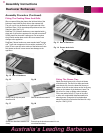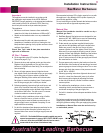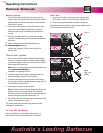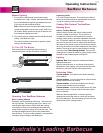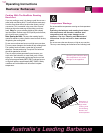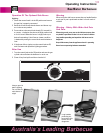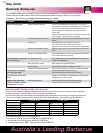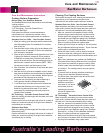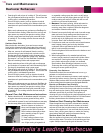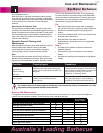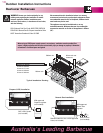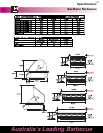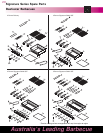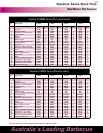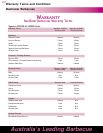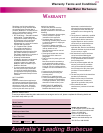Special offers from our partners!

Find Replacement BBQ Parts for 20,308 Models. Repair your BBQ today.

Australia’s Leading Barbecue
16
Beefeater Barbecues
Care and Maintenance
• Coat the grills with a layer of cooking oil. This will protect
the grills between barbecuing sessions. . Do not clean the
cooking grills in a dishwashing machine.
• Do not use highly caustic, harsh or abrasive chemical
cleaners to clean the cooking grills. (Always check the
manufacturer’s specifications and recommendations prior
to use).
• Before each subsequent use, preheat your BeefEater for
10 minutes before cooking. Allow the unit to cool off and
then remove any remains from previous cooking. Wipe
off with a paper towel and then lightly coat with a layer
of cooking oil. The cooking surfaces are now ready for
barbecuing.
Stainless Steel Grills
Many food acids, marinades, juices and sauces contain
highly acidic elements that will slowly attack the surface of
the stainless steel if not removed immediately after cooking.
• After use, remove all solid material from the cooking
surfaces using a brass bristle brush or plastic scourer.
Brushes specifically designed for this purpose can be
purchased from your BeefEater retailer (see “BeefEater
Accessories” on Page 72 of the BeefEater Cookbook).
Wipe off remaining residue with a paper towel.
• Gently wash the surface of the grills with a soft sponge
and a solution of hot water and a mild dishwashing liquid.
• Dry the grills immediately using a paper towel.
• Coat the grills with a layer of cooking oil. This will protect
the grills between barbecuing sessions. . Do not clean the
cooking grills in a dishwashing machine.
• Do not use highly caustic, harsh or abrasive chemical
cleaners to clean the cooking grills. (Always check the
manufacturer’s specifications and recommendations prior
to use).
• Before each subsequent use, pre-heat your BeefEater for
10 minutes before cooking. Allow the unit to cool off and
then remove any remains from previous cooking. Wipe
off with a paper towel and then lightly coat with a layer
of cooking oil. The cooking surfaces are now ready for
barbecuing.
General Care And Maintenance Instructions
1. Replace aluminium foil or absorbent material in drip tray
at regular intervals to prevent grease build-up, which
could result in a grease fire and void the barbecue warranty.
2. Use hot soapy water on the barbecue fascia and avoid
abrasive cleaners or brushes as
these could damage the surface and
graphics on the fascia. Clean the
entire barbecue thoroughly at least
twice annually to keep it in good
operating condition.
3. Keep cooking surfaces clean
by removing all solid matter after
use. A light coating of vegetable oil
or vegetable cooking spray after each use will help to
reduce surface rust and prolong plate and grill life. The
surface coating will wear off in time and cast iron will
rust (this is not covered by warranty).
4. Burners: Check main opening, throat and venturi to
each burner and pilot flame tube regularly for insect
nests (eg. wasp, ants or spiders). Nests are dangerous
and must be cleaned out thoroughly.
5. Remove burners periodically and scrub clean with soapy
water and a wire brush making sure that the ports are
free of obstructions. Replace burners in the correct
position and dry by lighting each one to avoid subsequent
corrosion. Rust is not covered by warranty.
6. For barbecues used near a marine environment however
more frequent cleaning and servicing should be
conducted. (More rapid deterioration can be expected
which is not covered by warranty).
7. Check and tighten all bolts and nuts on the barbecue and
trolley frequently.
8. When storing barbecue for extended periods keep
covered, and be certain all controls and cylinder valves
are turned off. If storing the barbecue indoors remove
gas cylinder and store the cylinder in a ventilated
area outdoors. Note: Allowing a barbecue to run for
10 minutes after cooking will help reduce cleaning by
burning off excess grease and juices.
Protecting Your Barbecue.
The barbecue should be covered when not in use. eg a
polyester or vinyl barbecue cover.
Near the ocean or salt water environment, wash regularly,
rinse and dry before covering. Covering a salt sprayed
Stainless Steel product while still wet will allow salt deposits
to form, causing rust to form even on very high grade Stainless.
Enamel and Stainless Steel Cleaning
Although Stainless Steel and Vitreous Enamel (Porcelain)
will keep their lustrous finish even under adverse conditions,
they still need regular cleaning. Dish washing detergent
and water are usually all you need. The frequency of
cleaning will vary according to the required appearance and
environment. To care for Stainless Steel or Porcelain Enamel
finishes, please observe the following instructions.
Stainless Steel Cleaning And Maintenance
Clean the appliance as required or at least twice annually
with hot soapy water. Avoid abrasive cleaners or brushes
as these will mark the porcelain enamel or stainless steel
surfaces of the appliance. If you cook food directly over the
burner flame, causing more vapour or smoke, the viewing
glass (where fitted) will need more frequent cleaning.
Stainless Steel Care And Cleaning
After the appliance has been used, wash down the surfaces
with hot soapy water. The surface of the stainless steel has
a grain. Always clean along the grain of the steel. This will



